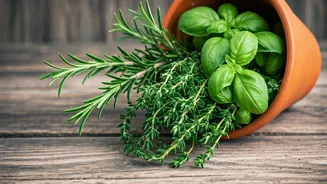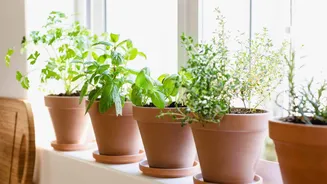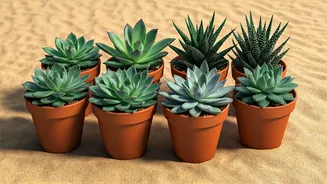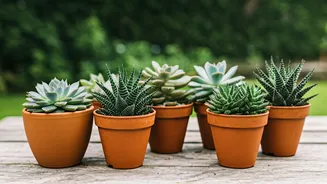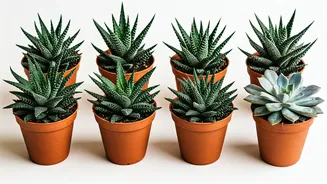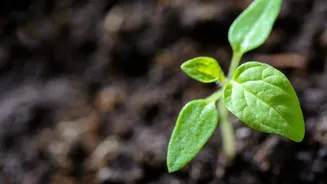Choosing the Right Herbs
The initial step in herb gardening involves selecting the herbs that best suit your needs and preferences. Consider factors like your local climate, available
space, and intended use of the herbs. For instance, if you live in a warm, sunny region, herbs like rosemary, thyme, and basil would likely thrive. Conversely, in a cooler, shadier area, herbs like mint, parsley, and chives could be a better choice. Medicinal herbs offer a wealth of health benefits and are a popular choice for home gardens. Some excellent choices include chamomile, known for its calming properties; Echinacea, used to boost immunity; and calendula, prized for its skin-soothing qualities. Culinary herbs, on the other hand, add flavor and aroma to your cooking. Popular options include basil, oregano, cilantro, and dill. Consider the flavors you enjoy and the dishes you frequently prepare when making your selections. Finally, think about the space you have available, whether it's a small balcony, a backyard garden, or even just a few pots on a windowsill. Some herbs, like mint, can be quite invasive, so consider growing them in containers to prevent them from spreading uncontrollably.
Watering Techniques for Growth
Watering is a crucial aspect of herb gardening, and understanding the right techniques can significantly impact your herbs' health and productivity. The frequency of watering depends on various factors, including the type of herb, the climate, and the soil conditions. Generally, herbs prefer consistent moisture but do not like to sit in waterlogged soil. Overwatering can lead to root rot, which can be fatal for your plants. A good rule of thumb is to water when the top inch of soil feels dry to the touch. When watering, apply water directly to the soil, avoiding wetting the leaves as much as possible. This helps prevent fungal diseases. Consider using a watering can with a rose head or a soaker hose to provide a gentle and even distribution of water. The best time to water herbs is in the morning, which allows the leaves to dry before nightfall, reducing the risk of fungal problems. Different herbs have slightly different water requirements. For example, Mediterranean herbs like rosemary and thyme are drought-tolerant and need less frequent watering, while herbs like basil and mint require more consistent moisture. Adjust your watering schedule based on the specific needs of each herb you're growing. Monitoring the plants for signs of underwatering, such as wilting leaves, or overwatering, such as yellowing leaves, will also help you to fine-tune your watering routine.
Growing Medicinal Herbs
Cultivating medicinal herbs at home provides a direct link to natural remedies and allows you to control the quality and cultivation practices. Many medicinal herbs are relatively easy to grow, making them suitable for both novice and experienced gardeners. Before planting, research the specific needs of each herb you intend to grow. This includes sunlight requirements, soil preferences, and watering needs. Most medicinal herbs thrive in well-drained soil and require at least six hours of sunlight per day. Prepare your soil by amending it with compost or other organic matter to improve drainage and nutrient content. When selecting seeds or seedlings, choose high-quality plants from reputable sources. Some popular medicinal herbs for home gardens include chamomile (Matricaria chamomilla), known for its calming and anti-inflammatory properties, and Echinacea (Echinacea purpurea), which is used to boost the immune system. Other options are Calendula (Calendula officinalis), used for skin ailments; and peppermint (Mentha × piperita), which aids digestion. Once your herbs are established, harvest them at the appropriate time to maximize their medicinal properties. For example, harvest chamomile flowers when they are fully open, and dry them in a well-ventilated, shaded area. Always research safe dosages and methods of preparation before using any home-grown herbs for medicinal purposes. Consider consulting with a healthcare professional or herbalist, especially if you are taking any medications or have any underlying health conditions.
Providing Adequate Light
Light is fundamental to the health and productivity of herbs. Understanding the light requirements of your chosen herbs and ensuring they receive the appropriate amount is essential for their growth. Most herbs require at least six hours of direct sunlight per day, particularly during the growing season. However, the exact amount of light needed varies depending on the specific herb. Herbs that originated in sunny, warm climates, such as rosemary, thyme, and oregano, generally thrive in full sun. On the other hand, herbs like parsley, mint, and chives can tolerate partial shade, meaning they need about four to six hours of sunlight per day. When growing herbs indoors, place them near a south-facing window, where they can receive the most sunlight. If you do not have enough natural light, consider using grow lights to supplement. Grow lights come in various forms, including fluorescent, LED, and high-pressure sodium lights. Choose a grow light that emits a spectrum of light suitable for plant growth. Observe your herbs for signs of insufficient light, such as leggy growth (long, stretched stems with few leaves), pale leaves, or a lack of flowering. If you notice these signs, move your herbs to a brighter location or supplement with grow lights. Additionally, consider the seasonal changes in light intensity. In winter, when days are shorter, your herbs may need more artificial light. In summer, be careful to protect your herbs from excessive heat and direct sunlight, which can scorch the leaves.
Using Quality Soil & Containers
The foundation of a successful herb garden relies heavily on the quality of soil and containers. Choosing the right soil and containers provides essential support for your herbs' health, growth, and overall success. Opt for a well-draining soil mix that is rich in organic matter. Herbs do not thrive in heavy, compacted soils, which can lead to root rot. A good quality potting mix for herbs typically includes a blend of ingredients such as peat moss, perlite, vermiculite, and compost. These components improve drainage, aeration, and nutrient retention. When selecting containers, consider both the size and material. The size of the container should be appropriate for the mature size of the herb you're growing. Choose a pot that is at least a few inches larger than the root ball of the herb. Ensure the container has drainage holes at the bottom to allow excess water to escape, preventing waterlogged conditions. The material of the container can also affect the growth of your herbs. Terracotta pots, for instance, are porous and allow for good air circulation, which can be beneficial for herbs that prefer drier conditions. Plastic containers are lightweight and retain moisture well, making them suitable for herbs that need more consistent watering. Another option is a fabric grow bag, as they promote excellent aeration and drainage. Before planting, ensure your containers are clean to prevent the spread of diseases. If you are reusing containers, wash them thoroughly with soap and water before planting new herbs.
Regular Maintenance Tips
Regular maintenance is crucial for keeping your herb garden thriving and productive. Providing the right care will ensure your herbs grow well and produce flavorful leaves and flowers. Regular watering is vital, as discussed earlier. However, the frequency should depend on the specific needs of each herb and the weather conditions. Fertilizing your herbs is another important aspect of maintenance. Herbs benefit from regular feeding to provide them with the nutrients they need for growth. Use a balanced, slow-release fertilizer or a liquid fertilizer diluted to half strength. Avoid over-fertilizing, as this can lead to excessive foliage growth and a loss of flavor. Pruning is another important aspect of herb care. Pruning encourages bushier growth, prevents the plants from becoming leggy, and promotes new growth. Pinch back the tips of your herbs regularly to encourage branching. Harvest herbs regularly to encourage new growth and prevent them from going to seed, which can reduce the production of flavorful leaves. Monitor your herbs regularly for pests and diseases. Common pests include aphids, spider mites, and whiteflies. Treat infestations promptly using organic methods, such as insecticidal soap or neem oil. Removing any yellowing or diseased leaves promptly is essential to prevent the spread of diseases. Provide your herbs with the support they need. Some taller herbs, such as rosemary or basil, may need staking to prevent them from flopping over. Consider mulching around your herbs. Mulch helps to retain moisture, suppress weeds, and regulate soil temperature.
